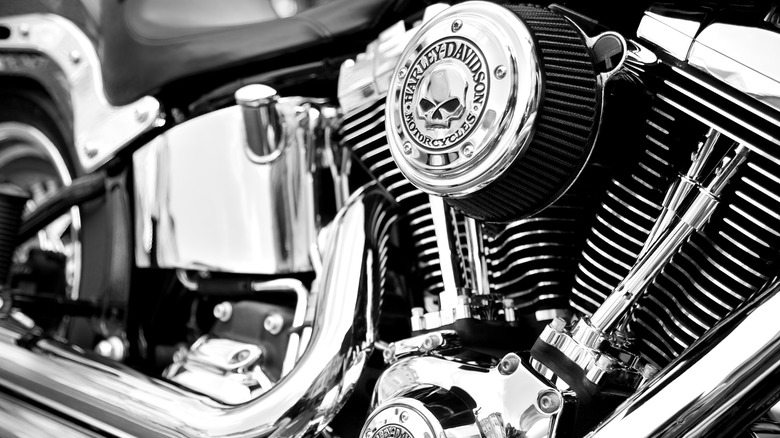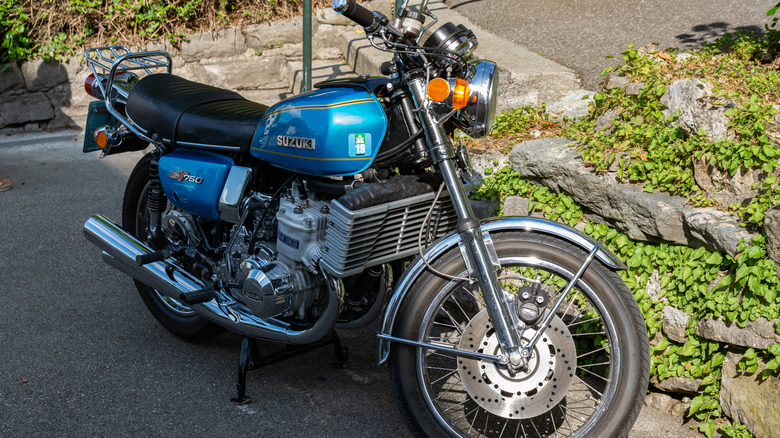Air Cooled Vs. Liquid Cooled Motorcycle Engines: The Pros And Cons Of Each
When one thinks of air-cooled motorcycles, vintage cruisers such as Harley-Davidson come to mind. However, Honda's wildly successful CB750 was also air-cooled. By comparison, liquid-cooled bikes came onto the scene much later; spearheaded by Suzuki in the early-1970s, and are typically associated with higher performance. However, is one method of keeping an engine cool truly superior to the other?
You can often identify an air-cooled engine by the fins on the engine block and/or cylinder head(s) that dissipate heat, and are sometimes used to striking visual effect, too. Airflow over the fins will help carry heat away more quickly. That said, if an air-cooled motorcycle remains stationary for a particularly long time, especially in hot weather, it's a good idea to shut the engine off to prevent overheating.
Air-cooled engines rely heavily on a proper tune to remain cool — especially the proper air-fuel ratio on a carbureted engine, which can sometime be set to an overly lean condition by the manufacturer to satisfy emissions requirements. It's also important to have fresh oil.
Oil gradually loses its ability to lubricate after repeated heat cycles, so do be diligent about sticking to your manufacturer's recommended oil change schedule. Similarly, many air-cooled bikes have a larger oil capacity than water cooled bikes to promote lower oil temperatures.
In general, air-cooled bikes are simpler, with significantly fewer parts to maintain. The drawbacks to air cooling are inconsistent operating temperature, greater noise levels, and increased possibility of overheating in stop and go conditions.
Spolier alert: liquid cooling wins
Liquid-cooled engines are sometimes called "water-cooled," though that's an oversimplification since anti-freeze and rust inhibitors are also in the mix. Like most internal-combustion-powered automobiles, liquid-cooled bikes have a radiator mounted in an area of high airflow: coolant circulates both inside the engine and back out through the radiator via water pump.
Often associated with higher levels of performance, liquid-cooled engines do serve more purposes than just engine cooling. Under pressure from the EPA to reduce exhaust emissions in the 1980s, motorcycle manufacturers found that it was easiest to keep air-fuel ratios consistent when engine temperature was steady, which could easily be regulated by the thermostat in a liquid-cooled system.
Coolant does need to be changed every so often, typically at two to five-year intervals. Rubber hoses are also consumable items, and the possibility exists that hard components like water pumps and radiators can develop leaks and other issues. On the surface, it seems like liquid-cooled engines have greater maintenance requirements, but that's not entirely true. Cooling systems may be more complex, but because the engine maintains a stable temperature, the service intervals for other engine components like checking valves are less frequent.
Liquid-cooled engines are also quieter than their air-cooled counterparts. Water passages surround the combustion chamber and serve to dampen the mechanical noise. Liquid cooling is clearly the way of the future, with holdouts like Harley-Davidson acquiescing to incorporate the technology into certain models. You can still purchase brand new air-cooled motorcycles today, but they're mostly older designs.

